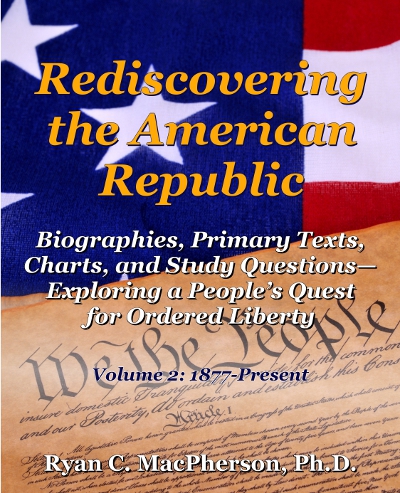Excerpted from: Rediscovering the American Republic, vol. 2: 1877–Present
In some periods of American history, great political leaders stand out for their ideas and actions that set the course for the nation. Such was the case, for example, with George Washington, John Adams, and Thomas Jefferson—the nation’s first three presidents. The decades preceding the Civil War are named “the Jacksonian Era” in honor of President Andrew Jackson, whose strong personality led to a complete realignment of politics during the 1830s. It happened again during the presidency of Abraham Lincoln in the 1860s. After Lincoln, however, a series of less-than-exemplary presidents followed; more precisely stated, the collective American memory has forgotten who those presidents were and what they did.
Politics during the late 1800s centered around controversies that today seem quaintly old-fashioned, if not downright boring: civil service reform, tariff rates, and the coinage of silver. Historians refer to this period as “the Gilded Age,” a phrase borrowed from the title of an 1873 novel by Mark Twain and Charles Dudley Warner. Even that book was no Adventures of Huckleberry Finn. And yet, Twain and Dudley hit the nail on the head in some respects. American corporations were acquiring unprecedented levels of wealth, and some capitalists were losing their scruples along the way. By the century’s end, sociologist Thorstein Veblen identified “conspicuous consumption” as a characteristic of this wealthy class (Theory of the Leisure Class, 1899):
In order to gain and to hold the esteem of men it is not sufficient merely to possess wealth or power. The wealth or power must be put in evidence, for esteem is awarded only on evidence. And not only does the evidence of wealth serve to impress one’s importance on others and to keep their sense of his importance alive and alert, but it is of scarcely less use in building up and preserving one’s self-complacency.
The Gilded Age, therefore, has often been regarded as not merely a time of wealth-production, but also a time of superfluous wealth-flaunting. “To gild” means “to layer something with gold,” but what if gold itself is gilded? William Shakespeare portrayed such ostentatious embellishment in King John (1595)—an apt description, in the view of many historians, for America’s own Gilded Age:
Therefore, to be possess’d with double pomp,
To guard a title that was rich before,
To gild refined gold, to paint the lily,
To throw a perfume on the violet,
To smooth the ice, or add another hue
Unto the rainbow, or with taper-light
To seek the beauteous eye of heaven to garnish,
Is wasteful and ridiculous excess.
But did Americans really become “wasteful and ridiculous” during the Gilded Age? A different way of telling the story would be to emphasize the manner in which captains of industry not only padded their own pocketbooks but also benefited others. As the profits of industrial monopolies grew, wages generally also increased among the working class. As mass-production lowered the per unit cost of manufactured goods, consumer prices fell. Potentially, everyone would benefit. The protective tariff, similarly, offered benefits not only to the investors who received dividends when local producers profited, but also to the wage workers who shared in those same profits. The Gilded Age, therefore, does not fit into neat and tidy categories, as if the wealthy always prospered and the poor always suffered.
Indeed, there is strong evidence that all social classes benefited in times of economic boom. On the other hand, the lower classes tended to suffer disproportionately during economic downturns, experiencing a decline in wages if not unemployment. Those who did have jobs often worked ten to twelve hours per day, six days per week, in factories where they repeated the same arduous—and often dangerous—task minute after minute. Often whole families, including children as young as ten years old, labored in the meat packing plants or coal mines, trying to cover their living costs and escape the seemingly endless cycle of debt.
In 1869, a secret fraternity known as the Knights of Labor began planning ways to improve the lot of laborers. Growing to a membership of 700,000 by 1886, the Knights focused especially on improving working conditions in the railroad industry. Terrence Powderly hoped the Knights could transform capitalism into a cooperative ownership by the workers, but his socialist visions never materialized. The organization fell apart by the end of the century, as members challenged Powderly’s leadership and led a haphazard series of strikes, several of which turned violent.
In December 1886, New York cigar maker Samuel Gompers established an alternative organization, the American Federation of Labor, which brought together skilled workers from a variety of trade unions. Unlike the Knights, the AFL did not seek to transform the nation’s political economy. Rather, Gompers sought to work within the capitalist system, primarily through the tool of collective bargaining. The AFL attempted to acquire higher wages and shorter working days for its members, while also respecting corporate leadership.
The captains of industry, meanwhile, offered a mixed response. For example, Andrew Carnegie sincerely sought to offer his workers a fair contract. On the other hand, Carnegie did not hesitate to hire the Pinkerton Detectives as a private police force to protect his steel mills from violent protesters. John D. Rockefeller, the founder of Standard Oil, also had a philanthropic spirit, but his endorsement of laissez-faire economics was subject to criticism, particularly during the Progressive Era (the early 1900s) when the federal government sought to break up the Standard Oil monopoly. A few academics, such as William Graham Sumner at Yale, unabashedly promoted an extreme laissez-faire philosophy, called social Darwinism—the notion that the economy fairs best when competition is fierce enough to promote the survival of only the fittest companies.
For its part, the federal government imposed few regulations on industry during the Gilded Age. First, there was the question of whether the government properly had a role in regulating the economic liberties of private entrepreneurs. Second, there was the question of whether the government had the means to do so. The Gilded Age, therefore, marked a time of puzzling contrasts. During 2008–2009, the federal government appropriated trillions of dollars to bail out failing banks and major industries, whereas in 1895, it was the finance captain J.P. Morgan who bailed out Uncle Sam! Yes, unprecedented economic progress at times was experienced across all social classes, yet monopolies amassed more power than the government and the unions combined. This was America during the Gilded Age.
The last of the Gilded Age presidents, William McKinley, brought America into a new order of world affairs. In part to protect business interests oversees, McKinley led the nation into a war against Spain in 1898. As a result, the old Monroe Doctrine of isolationism gave way to a new interventionism that continues to characterize American foreign policy even today. By the close of the nineteenth century, America had become an industrial giant; in the twentieth century (and beyond), its military power likewise would become a major player in global affairs.
- To learn more, purchase:
- See also:


